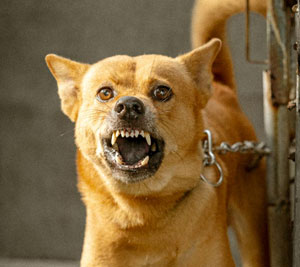
Understanding Dog Aggression
While a dog’s bark may seem scarier than its bite, aggressive behavior should never be ignored. Common signs of aggression include growling, baring teeth, snarling, snapping, or biting. But aggression isn’t just about biting—it includes any behavior meant to intimidate or harm a person or another animal.
Dogs use these actions as a form of communication. However, since humans and dogs communicate differently, it’s easy for misunderstandings to occur.
Why Dogs Show Aggression
From a dog’s point of view, there’s always a reason behind aggressive behavior. While a person may think they’re being friendly, a dog might see the same action as threatening. That doesn’t mean the dog is “crazy” or “vicious.” It simply means they’re reacting to a perceived threat based on their instincts or past experiences.
Types of Aggression in Dogs
Understanding the different types of aggression is key to managing behavior and ensuring safety for both your dog and others. Here are the most common forms of aggression and what they mean:
1. Dominance Aggression
This occurs when a dog feels its social status is being challenged. Dogs see their human family as part of their “pack” and may try to establish dominance within that group.
A dog who believes they rank higher than you may growl, snap, or become defensive when:
Moved from a favorite spot like the couch or bed
Hugged or physically restrained
Reached for by the collar or petted over the head
These dogs often behave well when unchallenged, but may quickly switch to aggressive behavior if they feel their control is threatened.
2. Fear-Motivated Aggression
This is a defensive behavior that occurs when a dog feels scared or threatened, even if no harm is intended.
For example:
A raised arm (even to throw a toy) might be seen as a threat.
A fearful dog may bite when approached by other dogs or unfamiliar people.
It’s all about the dog’s perception, not your intention.
3. Protective, Territorial, and Possessive Aggression
These types all involve defending something the dog values.
Territorial: Protecting space (home, yard, or even the whole block if the dog often marks during walks).
Protective: Guarding their family or pack members from perceived threats.
Possessive: Defending food, toys, or even odd items like tissues or socks.
4. Redirected Aggression
This happens when a dog gets frustrated or provoked but can’t reach the source—so it redirects the aggression elsewhere.
For instance:
Two dogs barking at a dog outside might turn and fight each other.
A leashed dog might snap at the owner when unable to reach a perceived threat.
5. Individual Variation
Some dogs react aggressively with very little provocation, while others tolerate many stressors without becoming aggressive.
This variation is influenced by:
Genetics
Environment
Age, gender, and breed
Personality and past experiences
The threshold for aggression can often be raised through proper behavior modification, though how much a dog improves depends on these factors.
Important Note
Aggression is complex and potentially dangerous. If your dog shows signs of aggression, it’s best to consult a professional animal behaviorist. Never attempt behavior modification techniques without proper guidance, as doing so incorrectly can make the problem worse.
Working with an expert ensures safety and helps your dog develop better behavior through proven methods.
What You Can Do About Aggression in Dogs
1. Rule Out Medical Issues
Start by visiting your veterinarian to ensure there are no health problems causing your dog’s aggressive behavior.2. Get Professional Help
Aggression doesn’t go away on its own. Work with an experienced animal behavior specialist—preferably in your home—who can assess and guide you properly.3. Keep Safety First
Your top priority is to protect people and other animals. Until you receive professional help:Supervise your dog closely.
Confine them to safe areas.
Use leashes, gates, or crates when needed.
If you must take your dog out in public, consider using a secure, cage-style muzzle (some dogs can remove soft muzzles).
4. Avoid Trigger Situations
Try to keep your dog away from situations or environments that might cause aggressive reactions. If necessary, limit their contact with others and keep them in a quiet, secure room.5. Manage Resources
If your dog guards toys, food, or spaces:Keep those items out of reach.
Prevent access to trigger areas.
In emergencies, trade the item with something better (like a tasty treat) to avoid confrontation.
6. Spay or Neuter Your Dog
Unneutered dogs are more likely to show aggressive behaviors related to dominance, protection, or territory. Spaying or neutering may help reduce this.
What NOT to Do When Dealing with Aggression
1. Don’t Use Punishment
Punishing your dog can often make aggression worse.If your dog is aggressive because of fear, punishment will increase that fear—and possibly lead to more aggression.
Trying to dominate a dog showing dominance aggression can make them fight back even harder, potentially leading to bites or serious attacks.
Punishing territorial, possessive, or protective aggression often causes your dog to become more defensive, not less.
2. Don’t Encourage Aggressive Play
Avoid games that teach your dog to compete with or challenge you.Rough games like tug-of-war or wrestling may lead your dog to try to “win” or “dominate,” which can cause problems with dominance aggression.
Encouraging barking, chasing, or reacting to sounds and people outside may lead to territorial or protective aggression.
Stay calm, set clear boundaries, and avoid situations that may escalate your dog’s behavior. Focus on building trust and seeking professional help if needed.
